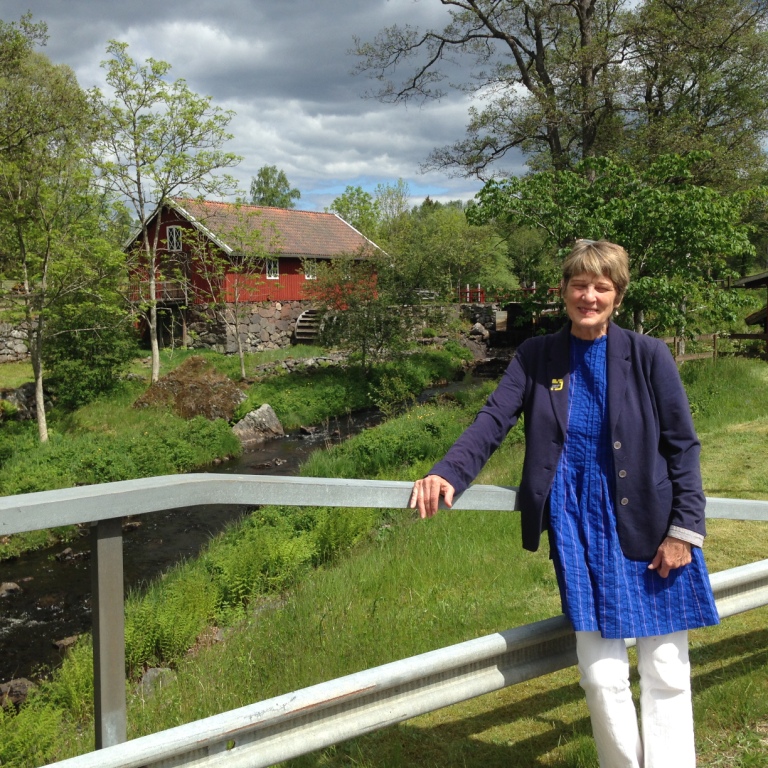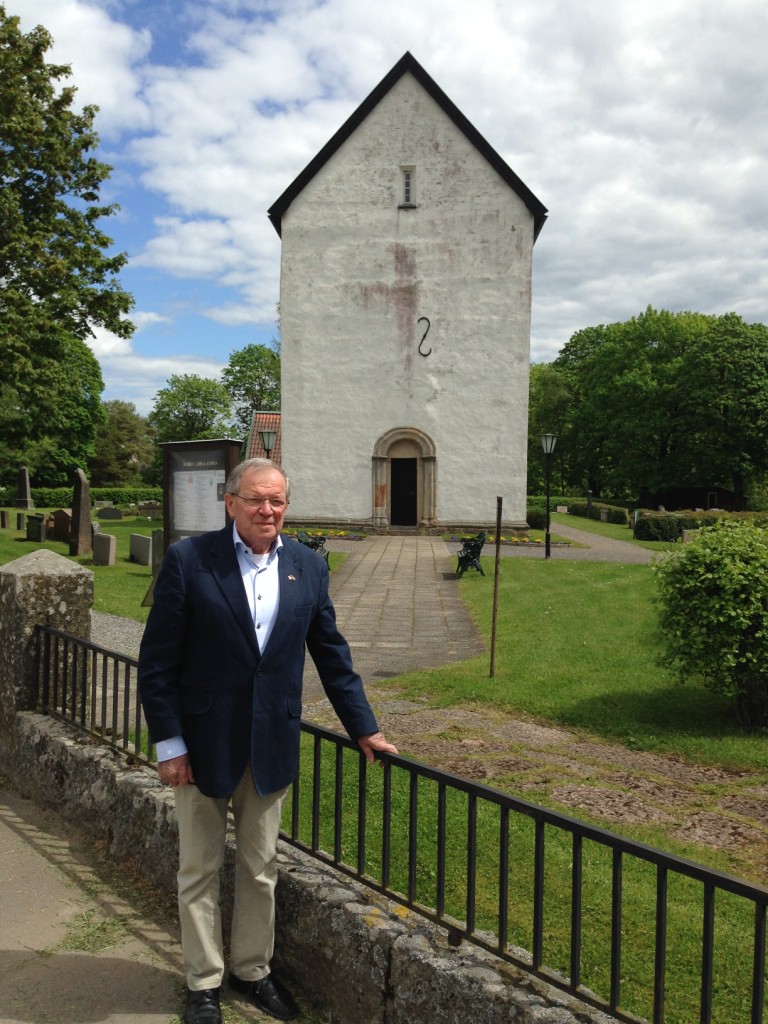
Photo courtesy Janet Norquist-Gonzalez
It’s been nearly four decades since I last visited Sweden. In 1976 my college roommate, Elisabet, suggested I visit her in Stockholm. It sounded like a good way to explore my Swedish roots for a few months, so I gladly accepted the invitation. I ended up staying nearly two years, long enough to fall in love with the culture.
For years after returning to the U.S.A., I subscribed to the children’s comic book, Bamse, to keep in touch with the language. Would I be able to communicate in Swedish with real people after such a long time? I was determined to try during another visit this summer, even though, as some people may know, all Swedes speak fluent English. My patient friends helped me to stumble through, though, and had fun listening to my Bamsespråk.
I made Stockholm my home base, staying with Elisabet and her husband Thomas, and took a day trip by train to Småland’s Jonas Bronck Center. My excuse for the trip was that I am an educator for The Bronx County Historical Society. Although I would only be at the center for a few hours, my plan was to begin researching events surrounding the early life of Jonas Bronck, the first European settler in the area now known as the Bronx, and to network with a few town officials and fellow educators.

Photo courtesy Janet Norquist-Gonzalez
Jonas Bronck was born in 1600 in the southern Swedish hamlet of Komstad, the town most historians now accept as Bronck’s birthplace. Located just outside of Sävsjö municipality in Småland, Sävsjö is like the U.S.A.’s Minnesota. It is a sparsely populated area graced with fertile, yet stony forested farmland and gleaming chains of lakes and streams. But why would young Jonas leave such a beautiful place, leave his family, and make his way out into the world?
Curt Wrigfors, a successful Swedish businessman and the founder of the Jonas Bronck Center in Sävsjö, offers some clues. Recently retired, he has made it his avocation to help people on both sides of the Atlantic to know more about Jonas Bronck. He organizes a yearly celebration at the Center.
My destination, Sävsjö Station, was inaugurated in 1864, when the community consisted of only a few houses. Because of the railway, carpentry and other wood-related industries grew. Mr. Wrigfors met my train, and graciously took me under his wing, whisking me off to meet with fellow history buffs and educators. Over a typical smörgåsbord luncheon, we shared ideas on how to network student historical research projects in Sävsjö to those going on at the Bronx County Historical Society’s Museum of Bronx History. We discussed mapmaking, newspaper production, quilting, theater projects, and other possible educational means.
The Jonas Bronck Center is located near several sites that already existed during Jonas Bronck’s childhood. The Center’s exhibit provides a glimpse into the lives of people associated with Jonas Bronck from both sides of the ocean, then and now.
Obviously Sweden has changed dramatically over the years, from centuries of feudal oppression to a modern social democratic system where there is virtually no poverty or homelessness. At the time of Jonas Bronck’s childhood, however, life was in many ways filled with turmoil for the people of Småland. They were surrounded by war, famine, and oppression. The church, feudal lords, royalty, all demanded impossible tributes and taxation from the poor.
While driving me around, Mr. Wrigfors described life in Sävsjö during Jonas Bronck’s childhood. The area still includes the mill site where farmers processed their grain, the 12th century Norra Ljunga Church where young Jonas was baptized, and the Ecksjö Court Mansion that dates back to the 15th century.
One can visit a hill where alleged heretics were beheaded, and a place where religious fanatics burned women accused of being witches, their fates having been determined by purported eyewitness accounts extracted from children. During this period, Sweden was at war with Denmark, and Danish soldiers occupied much of southern Sweden. Jonas Bronck would have been under pressure to choose a side and join up. Most of Europe was in fact on the verge of some kind of conflict. The Thirty Years War was about to throw Swedish, Danish, and French Protestants into a bloody revolt against German Catholic religious oppressors. It seemed like an easy decision for young Jonas to leave his homeland and seek his fortune elsewhere.
In today’s Sävsjö, Danish soldiers no longer torment its inhabitants unless it is with silly jokes. It has a rustic feel to it, and, although there are no big tourist attractions, for a history buff, it provides a fascinating and peaceful vacation. It is a great place for a bicycle tour. My parents did it on a tandem bike back in 1947. There are hotels and a lovely camping site on Sävsjö’s lake, simple Swedish food in quaint restaurants, and it is close enough to Stockholm to make a quick day-trip of it, as I did.
I found, as in every place I visited in Sweden, that potatoes accompany almost every meal, usually with a generous dollop of butter, salt and dill. Add a portion of herring and a side of salad, and you will have a typical Swedish meal. My brother, John, claims that the Swedes invented hospital food, but I have found it a lot more interesting. Traditional weekday specials in small cafés might include split pea soup accompanied by pancakes with lingonberry preserves, or Swedish meatballs with cream sauce, mashed potatoes, pickled gherkin, also with lingonberry preserves. A konditori will serve coffee with an assortment of sandwiches, sweets and gooey pastries, making one wonder why obesity is so rare in Sweden. I decided not to worry about it. I ate kanel bullar (cinnamon buns) and princess torte (cake swathed in marzipan) with impunity, did a lot of hiking as compensation, and, like any good Swede, came home five pounds lighter.
Editor’s Note: Janet Norquist-Gonzalez is a cartographer and teacher at the Bronx County Historical Society. She is the organist and choir director for Epiphany Lutheran Church.





As the Founding Director of the Jonas Bronck Center, I am happy to see another American of Swedish ancestry visit Jonas Bronck’s village in Sweden. Over 33 years ago, Lloyd Ultan (now official Borough Historian) put me on to newly discovered information – I was researching my own Swedish ancestry at the time. So, using documentation, I began to promote what most have now come to accept – Jonas Bronck was a Swede by birth.
Last year was the 375th Anniversary of his settlement of the area that would ultimately bear a version of his name. I had formed the 350th Anniversary Commission 25 years earlier with the Borough President’s office. This time around it was the Swedes who reached out to me. This time around, also, the Borough President’s office preferred to concentrate on the Centennial of Bronx County (1914). The Bronx was well-represented at our event in Savsjo by Lenny Caro of the Bronx Chamber of Commerce. We got wonderful New York Times and international press coverage as well.
http://www.nytimes.com/2014/08/20/nyregion/from-bronck-to-the-bronx-a-name-and-a-swedish-heritage-to-celebrate.html
Mr. Wrigfors is no longer associated with our efforts, but one can visit the homepage http://www.JonasBronck.se (being updated) or me directly at BGAndersson2@gmail.com.
The Bronx is UP!
Brian G. Andersson
Former Commissioner, NYC Dept. of Records
Brian G Andersson was not founder of Jonas Bronck Center he was member of the board round about six month.
I was clear: a Founding Director. All based on my work which Mr. Wrigfors heard about from a previous Swedish Consul General in New York.